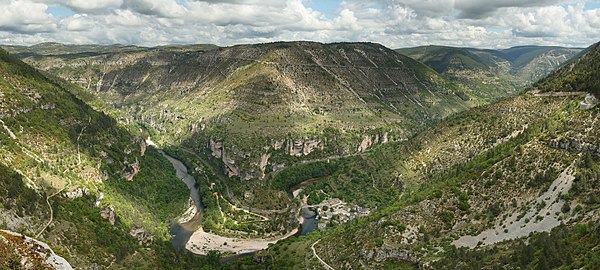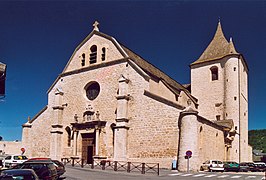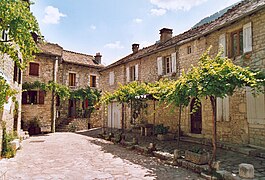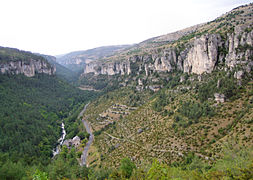| Lozère Losera (Occitan) | |
|---|---|
| Department | |
    From top down, left to right: Sainte-Enimie, the Gorges du Tarn in La Malène, Castle of Florac, Mont Lozère From top down, left to right: Sainte-Enimie, the Gorges du Tarn in La Malène, Castle of Florac, Mont Lozère | |
 Flag Flag Coat of arms Coat of arms | |
 Location of Lozère in France Location of Lozère in France | |
| Coordinates: 44°20′N 3°36′E / 44.333°N 3.600°E / 44.333; 3.600 | |
| Country | France |
| Region | Occitanie |
| Departement | 4 March 1790 |
| Prefecture | Mende |
| Subprefecture | Florac Trois Rivières |
| Government | |
| • President of the Departmental Council | Sophie Pantel (PS) |
| Area | |
| • Total | 5,167 km (1,995 sq mi) |
| Population | |
| • Total | 76,503 |
| • Rank | 102nd |
| • Density | 15/km (38/sq mi) |
| Demonym | Lozériens |
| Time zone | UTC+1 (CET) |
| • Summer (DST) | UTC+2 (CEST) |
| ISO 3166 code | FR-48 |
| Department number | 48 |
| Arrondissements | 2 |
| Cantons | 13 |
| Communes | 152 |
| Website | lozere.fr |
Lozère (French pronunciation: [lɔzɛʁ] ; Occitan: Losera [luˈzeɾɔ]) is a landlocked department in the region of Occitanie in Southern France, located near the Massif Central, bounded to the northeast by Haute-Loire, to the east by Ardèche, to the south by Gard, to the west by Aveyron, and the northwest by Cantal. It is named after Mont Lozère. With 76,604 inhabitants as of 2019, Lozère is the least populous French department.
History
Lozère was created in 1790 during the French Revolution, when the whole of France was divided into departments, replacing the old provinces. Lozère was formed from part of the old province of Languedoc.
Pliny's Natural History praised the cheese of Lozère:
- The kinds of cheese that are most esteemed at Rome, where the various good things of all nations are to be judged of by comparison, are those that come from the provinces of Nemausus, and more especially the area there of Lesura and Gabalis (Lozère and Gévaudan); but its excellence is only very short-lived, and it must be eaten while it is fresh.
Between 1764 and 1767, the Beast of Gévaudan, a creature believed to be a large wolf or an exotic animal, terrorized the general area in the Margeride Mountains of the former province of Gévaudan (nearly identical with the modern Lozère department).
Geography
Lozère has an area of 5,167 km (1,995 sq mi). It is the northernmost department of the current Occitanie region and is surrounded by five departments belonging to two regions: Cantal, Haute-Loire and Ardèche departments of the Auvergne-Rhône-Alpes region, and Gard and Aveyron departments of the Occitanie region.
| Places adjacent to Lozère | ||||||||||||||||
|---|---|---|---|---|---|---|---|---|---|---|---|---|---|---|---|---|
| ||||||||||||||||
The geography of Lozère is complicated, covering four mountain ranges. In the north-west, the basalt plateau of Aubrac rises between 1,000 and 1,450 m (3,280 and 4,760 ft), with a cold humid climate influenced by the Atlantic. The north and north-east of the department contains the Margeride mountains, which are formed of granite, and have peaks between 1,000 and 1,550 m (3,280 and 5,090 ft). The climate here is also cold, but drier than in Aubrac, with less snow.
The Causses are a series of very dry limestone plateaus in the south-west, and the south-east contains the Cévennes, which include the highest point in the department, the granite Mont Lozère at 1,702 m (5,584 ft).
The department also contains numerous rivers, above and below ground, including the Tarn, whose source is on Mont Lozère, and which flows through the Gorges du Tarn in the Causses.
 View over the cirque of Pougnadoire and Saint-Chély-du-Tarn village, in the Tarn Gorges
View over the cirque of Pougnadoire and Saint-Chély-du-Tarn village, in the Tarn Gorges
Demographics
Population development since 1801:
|
| ||||||||||||||||||||||||||||||||||||||||||||||||||||||||||||||||||||||||||||||||||||
| |||||||||||||||||||||||||||||||||||||||||||||||||||||||||||||||||||||||||||||||||||||
| Sources: | |||||||||||||||||||||||||||||||||||||||||||||||||||||||||||||||||||||||||||||||||||||
Lozère is the least populated French department, and the least densely populated in Metropolitan France. Its 2019 population of 76,604 gives it a population density of 14.8 inhabitants/km. The department boasts a population similar in size to that of the country of Andorra, the neighbouring country that borders to the south. Since the end of the 19th century the department has seen its population decline due to negative migration, the last fifteen years have nevertheless shown a new upward trend. The reasons given for this trend are the quality of the living environment, the improvement of the road transport and communication network and to a lesser extent heliotropism. It is nevertheless an elderly population with high purchasing power. The inhabitants of Lozère are known, in French, as Lozériens and Lozériennes.
The population is concentrated in three main urban centers: Mende, Saint-Chély-d'Apcher and Marvejols which together account for a third of the department's population. Some other small centers (Langogne, Florac, Aumont-Aubrac, La Canourgue, etc.) appear as small living areas but are unable to attract young people, including the exodus towards neighboring metropolises (Clermont-Ferrand in the north, Montpellier and Nîmes to the south) is increasingly important.
Because of its low population density, it is considered to fall within the empty diagonal.
Principal towns
The most populous commune is Mende, the prefecture. As of 2019, there are 3 communes with more than 3,000 inhabitants:
| Commune | Population (2019) |
|---|---|
| Mende | 12,318 |
| Marvejols | 4,684 |
| Saint-Chély-d'Apcher | 4,211 |
Administration
The département is managed by the Departmental Council of Lozère in Mende. As of 2015, the President of the council is Sophie Pantel. Lozère is part of the region of Occitanie.
Administrative divisions
There are 2 arrondissements, 13 cantons and 152 communes in Lozère.
| INSEE code |
Arrondissement | Capital | Population (2019) |
Area (km) |
Density (inhabitants/km) |
Communes |
|---|---|---|---|---|---|---|
| 481 | Florac | Florac | 13,050 | 1,687 | 7.7 | 38 |
| 482 | Mende | Mende | 63,554 | 3,479 | 18.3 | 114 |
The following is a list of the 13 cantons of the Lozère department (with their INSEE codes), following the French canton reorganisation which came into effect in March 2015:
- Bourgs sur Colagne (4803)
- La Canourgue (4802)
- Le Collet-de-Dèze (4804)
- Florac Trois Rivières (4805)
- Grandrieu (4806)
- Langogne (4807)
- Marvejols (4808)
- Mende-1 (4809)
- Mende-2 (4810)
- Peyre en Aubrac (4801)
- Saint-Alban-sur-Limagnole (4811)
- Saint-Chély-d'Apcher (4812)
- Saint-Étienne-du-Valdonnez (4813)
Economy
The main activities are cattle farming and tourism. There is barely any arable farming in Lozère due to poor soil quality. The hardy Aubrac is the most commonly farmed cattle breed here.
The region has one of the lowest rates of unemployment in France, which may be attributed to the enforced long-standing tradition whereby young people emigrate to cities such as Lyon, Marseille, and Montpellier when they reach working age.
Land use

Lozère is a rural department, with relatively little land taken up by roads and buildings. Overall the land use is divided as follows:
- Forest 43.81%
- Heath & other open land 31.19%
- Arable land 12.74%
- Fields 11.36%
- Roads and buildings 0.54%
- Rivers and ponds 0.3%
Politics
Current National Assembly Representative
| Constituency | Member | Party | |
|---|---|---|---|
| Lozère's constituency | Sophie Pantel | Socialist Party | |
Tourism
Tourist activities include caving and a variety of sports, such as skiing and kayaking. Lozère contains a part of the Cévennes National Park. Lozère is considered one of the best areas in France for trout fishing. Rivers such as the Lot, Tarn and Truyère are particularly noted for their trout populations.
-
Mende
-
 Church of Marvejols
Church of Marvejols
-
 Sainte-Enimie, one of the most beautiful villages of France
Sainte-Enimie, one of the most beautiful villages of France
-
 Cévennes National Park
Cévennes National Park
See also
- Arrondissements of the Lozère department
- Cantons of the Lozère department
- Communes of the Lozère department
- Crueize Viaduct
Explanatory notes
- Pliny's term is pagus, a Latin equivalent of pays.
References
- "Répertoire national des élus: les conseillers départementaux". data.gouv.fr, Plateforme ouverte des données publiques françaises (in French). 4 May 2022.
- ^ "Département de La Lozère (48) - Résumé statistique". Publications et statistiques pour la France ou les régions (in French). Institut national de la statistique et des études économiques - INSEE. Retrieved 18 August 2015.
- "Populations de référence 2022" (in French). The National Institute of Statistics and Economic Studies. 19 December 2024.
- ^ Populations légales 2019: 48 Lozère, INSEE
- ^ "Historique de la Lozère". Le SPLAF. Retrieved 8 July 2022.
- Pliny, Naturalis Historia book XI, ch 97:200-202.
- "Évolution et structure de la population en 2016". INSEE.
- Le nom des habitants du 48 - Lozère, habitants.fr
- "Département de La Lozère (48)" (in French). Institut national de la statistique et des études économiques - INSEE. Retrieved 18 November 2024.
- "Décret n° 2014-245 du 25 février 2014 portant délimitation des cantons dans le département de la Lozère" (in French). Légifrance.gouv.fr. Retrieved 18 August 2015.
- Nationale, Assemblée. "Assemblée nationale ~ Les députés, le vote de la loi, le Parlement français". Assemblée nationale.
External links
- Departmental Council of Lozère (in French)
- Prefecture website (in French)
- Comité Départemental du Tourisme en Lozère (in French)
- "Lozère" . Encyclopædia Britannica (11th ed.). 1911.